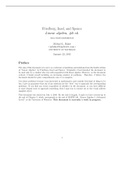Exam (elaborations)
Friedberg, Insel, and Spence Linear algebra, 4th ed. SOLUTIONS REFERENCE
- Course
- Institution
Friedberg, Insel, and Spence Linear algebra, 4th ed. SOLUTIONS REFERENCE Preface The aim of this document is to serve as a reference of problems and solutions from the fourth edition of “Linear Algebra” by Friedberg, Insel and Spence. Originally, I had intended the document to be used o...
[Show more]



